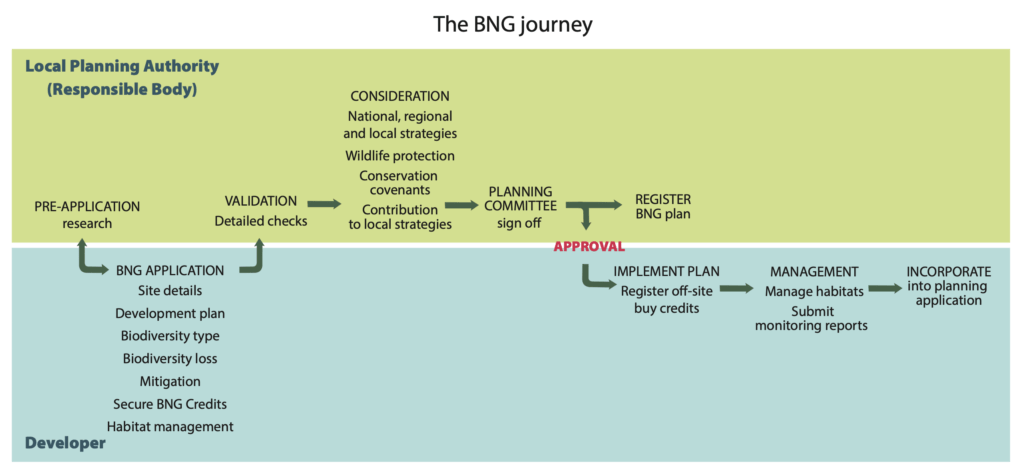If you’re a developer preparing to work on a site in Yorkshire, it’s crucial to understand the significance of Environment Law 2021 and Biodiversity Net Gain (BNG).
Starting February 2024 , BNG is now mandatory and local planning authorities now require developers to demonstrate a 10% biodiversity net gain over the pre-development value before granting planning consent. However, there are some exceptions to this rule, including national infrastructure projects until 2025 and certain minor residential plans.
Civity can help you with surveys, searches, units and advice in Yorkshire—all you need to do for a successful BNG plan. Contact us today for some expert guidance or help.


Local authorities across the board have their distinctive strategies to fulfill diverse obligations, spanning from local concerns to national and environmental issues. With Biodiversity Net Gain (BNG), the shift is clear – it’s no longer a voluntary measure but a mandatory one. The Local Planning Authority (LPA) factors in a multitude of elements, including attitudes, knowledge, politics, both local and national strategies, discretion, and the immediate imperatives when evaluating your BNG plan. It’s vital to know how to present your application effectively. That’s where Civity comes in. We have a strong track record of collaborating with LPAs to facilitate their understanding and application of BNG

So, what is involved and how fast is the process?
The principal players are you and the local planning authority or Responsible Body. However, others play indispensable roles:

Landowners, agents, brokers and land banks may be able to provide the necessary biodiversity units. Bear in mind there are rules; for example, the value of off-site biodiversity units diminish with the distance from your site. A similar or better type of habitat must replace the type of biodiversity degraded on your site. So, if you compromise a high-quality habitat on-site, you are going to find it harder and costlier to replace it with similar or better.

The local planning authorities or responsible bodies will be guided and governed by many considerations: Their own environmental strategies, locally important habitats, Biodiversity Action Plans, green infrastructure strategies, Local Nature Recovery Strategies, Section 106 agreements, conservation covenants and more. It is clear that every LAP has its own inimical strategies, plans, pressures and preferences.

Only an experienced, qualified ecologist can survey your site to establish the type of habitats and their value that your development and its construction will impact. They will also look for any mitigation of on-site biodiversity that would reduce the offset required to reach a 10% gain.


Continued...

Stakeholders may not be directly financially involved but can wield considerable influence on support, strategy and decision-making.

Natural England, a government quango working with DEFRA, has developed the standard Metric. Now version 4.0 has been evolving for some years and could continue to evolve in the future.

The government itself is expanding the law or amending it. In April 2024, BNG will apply to smaller land parcels and specialist housing. A national infrastructure strategy can create exceptions; for example, the recent unlocking of the development of 100,000 new homes blocked by “defective” EU Laws. The government has also published a list of statutory units which values the different habitat types. However, the price of Biodiversity units are subject to market forces; statutory units are a last resort.

Below is a schematic plan that shows the journey your BNG Plan will take as it reaches implementation. Every LPA will apply its own judgement, but the route below, is typical.

The Process Continued
The process starts with getting to know the LPA and the area of its operations.
Next, you need to assemble all the data required by the LPA to make a fair decision. The data should not only show details of the proposed development but the net loss or gain in BNG metrics and how the net gain of 10% will be achieved. It will be necessary to secure the biodiversity units (not necessarily buy them at this stage) and your plans for maintaining or improving the compensating habitats for 30 years. This obligation can be legally mitigated, for example, by buying the units from a land bank like Civity who will discharge you of all responsibility.
The next stage is the validation of the data you have provided. The veracity of every detail will be scrutinised, the qualifications of the experts checked, and the credibility of your 30-year obligation to maintain and improve the compensating habitats will be closely examined.
Once the validation is complete, consideration will be given to the application’s compatibility with any legal restrictions (conservation covenants) in place and take into account the relevant national, regional and local environmental strategies.
If all is well, your BNG plan will be approved and registered. As yet, there is no formal national register of biodiversity units, but it is in the pipeline.
This is the stage where you must buy your Biodiversity Units and make arrangements for the secured habitat’s protection and enhancement.
At last, you can seek to have your application for planning permission approved; you cannot gain consent without first having the approval of your BNG plan.

Every LPA is different; some embraced the Environment Act 2021 in its formative years. Others have lagged behind. Some will have systems in place to deal with an application efficiently, others will be learning as they go. Some applications will glide through the process, others will stutter as much by the size, nature and location of the development as by the experience of the LPA concerned. You should assume it will be a lengthy process and only a preliminary stage to seeking planning permission.

Talk to us at Civity. We can ease the path through the biodiversity maze. Our directors are experienced in ecology, finance, land management and property development. We work with local authorities and responsible bodies, with landowners, leaseholders, schools and stakeholders.
We are authorised to sell biodiversity units and are driven by the ethics and practices of the Chartered Institute of Ecology and Environmental Management (CIEEM), the leading professional membership body representing and supporting ecologists and the environment.
The initial enquiry is free.
Biodiversity Net Gain is a measure of the variety of wildlife in a natural environment, essential for developers and effective land management. It’s a measure of how rich in species an area is, or how much rare or innately valuable wildlife is present in the natural environment. A Biodiversity Net Gain is the difference between the ecological loss caused by a development’s land take and the compensating ecological gain on the same or on other sites. It is a crucial aspect of the Environment Act 2021, emphasising the need for developers to consider sustainable land management practices that contribute to deliver biodiversity net gain, including efforts to create wildlife habitats. The principal aim of this act is to leave the natural environment in a measurably better state than it was. Planning permission for qualifying building development can be granted without proof of a minimum 10% Biodiversity Net Gain, underscoring the significance of developers’ commitment to responsible land management that includes delivering biodiversity net gain.
When development projects takes place, there is always some damage to the ecology of the site. The Environment Act 2021 makes it mandatory from January 2024 to compensate for resulting biodiversity loss. The compensation can be done by creating new habitats or enhancing the value of existing habitats. When this compensation is done offsite, away from the development site, it is called a Biodiversity Offset.
The UK’s increasing population has made corresponding demands on developers, land managers, and existing habitats. This now seriously affects our lives and the ecology of our wildlife, so the government has intervened, not just to halt further decline, but to build, repair, and maintain habitats and to help preserve the environment for future generations.
Biodiversity Offsets present an opportunity to pool significant resources from multiple developments into large, well-designed, and strategic habitat creation projects. This approach, in line with the biodiversity net gain approach and local nature recovery strategies, will result in the creation of ‘bigger, better, and more joined up’ ecological networks for our wildlife habitats, enhancing the connectivity of existing habitats.
If a development site is unable to produce a 10% increase in the difference between its pre- and post-biodiversity value on site, it must offset the loss by acquiring Biodiversity Units elsewhere. Under the terms of The Environment Act, the gain should be onsite and, if this is impossible, close to the development site. If that is not possible, Biodiversity Units may be bought further afield but their value may be reduced.
Biodiversity Metric 4.0 is a biodiversity accounting tool created by Natural England that can be used for the purposes of calculating Biodiversity Net Gain. It is a key tool that supports the delivery of Biodiversity Net Gain and is used to calculate the baseline biodiversity value of a site in terms of biodiversity units, and forecast its future biodiversity value. It is the standard biodiversity measurement designed for use by ecologists, developers, planners, and other interested parties.
Biodiversity Net Gain differs from previous local plans laws in that the Environmental Act 2021 makes the biodiversity gain mandatory. The mandatory Biodiversity Net Gain is legally secured between two (or more) consenting parties, private or public, using a Section 106 agreement (securing the land for biodiversity purposes) or a Conservation Covenant.
This is the major change to the Planning rules: The Environment Act sets out a ‘general condition’ that should be applied to all planning permission applications, requiring a Biodiversity Gain plan to be submitted and approved before the start of development, ensuring that biodiversity net gain requirements are achieved on site.
DEFRA and Natural England are preparing a ‘site register’ of approved biodiversity offsetting land. This register may be formed by multiple different providers, including landowners themselves, private brokers, land banks, or local planning authorities.
The ultimate gain is for the environment. The time has come for everyone. Who uses the environment for self-interest to make a significant contribution for its preservation. For developers, a making Biodiversity Net Gain of 10% minimum is a mandatory requirement to obtain planning permission from the local planning authority; for landowners, unproductive land can produce a revenue stream in the form of rent and management funding for 30 years without loss of access. Together, developers and landowners can dovetail their interests for the benefit of future generations.
We offer BNG units for sale in various locations across the UK, ensuring you have access to biodiversity solutions tailored to your area. Our key locations include:
Each of these areas is strategically selected to support local planning authorities, developers, and landowners in meeting biodiversity net gain requirements. If you’re looking for a specific location or need advice on availability, please don’t hesitate to contact us.

If you would like to earn more about, and how to benefit from, Biodiversity Net Gain for your development inYorkshire, contact hello@civitynge.com

3a Orbis Wharf,
Bridgers Court Road,
SW11 3GW
Manage by Growth4Trades
Automated page speed optimizations for fast site performance